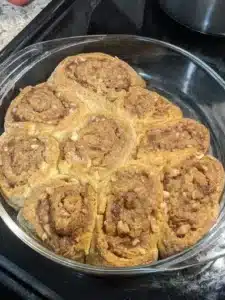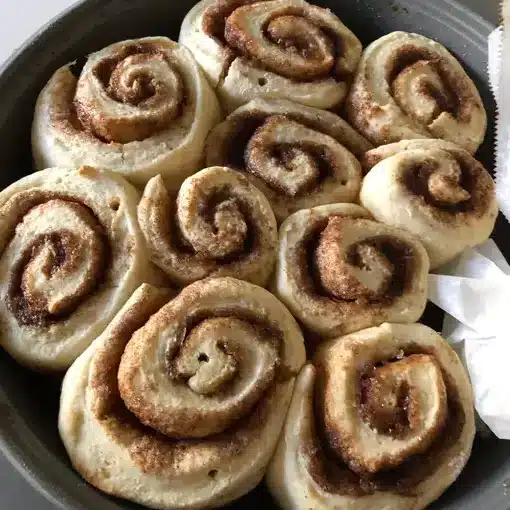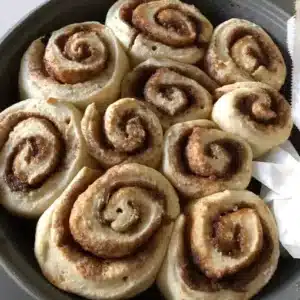Introduction to Cinnamon Rolls
Cinnamon rolls, those delightfully sweet and aromatic pastries, have captivated taste buds around the world. Their journey from a simple baked good to a global phenomenon is as rich and layered as the rolls themselves.

The Historical Roots
The origin of cinnamon rolls is a tapestry woven with various cultural threads. While the exact beginnings are somewhat shrouded in mystery, it’s widely believed that they have their roots in ancient history. The use of cinnamon, a spice once more valuable than gold, dates back to ancient Egypt, where it was used in embalming processes and as a flavoring in beverages. However, the cinnamon roll as we know it today likely originated in Northern Europe, particularly in Sweden and Denmark, where they are known as ‘kanelbulle’ and ‘kanelsnegl’ respectively.
- Ancient Spice, Modern Delight: Cinnamon’s journey from a precious commodity to a kitchen staple is a fascinating story in itself. Learn more about the history of cinnamon.
- European Influence: The Scandinavian countries, with their rich baking traditions, played a pivotal role in evolving the cinnamon roll to its current form.
The Rise to Popularity
Initially, cinnamon rolls were a luxury item, enjoyed primarily by the upper class due to the high cost of cinnamon. However, with the spice becoming more accessible, these rolls found their way into the hearts and homes of people across different social strata. The 20th century saw a significant surge in their popularity, especially in the United States, where they became a staple in bakeries and households alike.
- A Symbol of Comfort: Often associated with warmth and comfort, cinnamon rolls have become a symbol of homely indulgence. From family gatherings to coffee breaks, they hold a special place in many cultures.
The Evolution of the Recipe
Over the years, the cinnamon roll has undergone numerous transformations, adapting to local tastes and preferences. From the classic, buttery rolls dripping with icing to more health-conscious versions with whole grains and less sugar, the evolution of the cinnamon roll reflects changing dietary trends and preferences.

- Global Variations: Each region has added its unique twist to the classic recipe, making the cinnamon roll a versatile and ever-evolving treat.
The Cultural Significance
Cinnamon rolls are more than just a delicious snack; they are a cultural phenomenon. They have become synonymous with comfort food and are often featured in media and literature as a symbol of warmth and hospitality.
- In Literature and Media: The cinnamon roll has been romanticized in books and movies, often depicted as the epitome of home-cooked goodness.
The Perfect Dough for Cinnamon Rolls
Creating the perfect dough is fundamental to achieving the ultimate cinnamon roll experience. This section delves into the essential ingredients and steps to ensure your cinnamon rolls are soft, fluffy, and utterly irresistible.
Key Ingredients for Success
The journey to perfect cinnamon rolls begins with selecting the right ingredients. Each component plays a crucial role in the texture and flavor of the dough.
- Flour: The foundation of your dough, all-purpose flour is ideal for achieving a soft texture. For a chewier texture, you can opt for bread flour.
- Sugar: Granulated sugar not only sweetens the dough but also feeds the yeast, aiding in fermentation and rise.
- Yeast: A crucial ingredient, yeast is responsible for the rise and fluffiness of the rolls. Instant yeast is recommended for its reliability and shorter rise time. Learn more about working with yeast.
- Milk: Whole milk contributes to the richness of the dough. Buttermilk can be a great alternative, adding a slight tang.
- Butter: Essential for a rich, tender dough.
- Egg: Adds richness and structure to the dough.
Step-by-Step Dough Preparation
- Mix Dry Ingredients: Start by whisking together the flour, sugar, and a pinch of salt.
- Warm the Milk: Heat the milk and butter until warm but not hot. Stir in the yeast and let it dissolve.
- Combine and Knead: Mix the wet ingredients into the dry, add the egg, and knead until you have a smooth, elastic dough.
- First Rise: Let the dough rest in a warm place until it doubles in size, which is crucial for developing the texture.
Tips for Getting the Dough Right
- Temperature Matters: Ensure your milk and butter mixture is warm, around 100-110°F, to activate the yeast without killing it.
- Kneading is Key: Knead the dough until it’s smooth and elastic. This develops the gluten, which gives the rolls their structure.
- Let it Rise: The first rise is essential for flavor and texture. Find a warm, draft-free spot to encourage the yeast to work its magic.
Common Mistakes to Avoid
- Overheating the Milk: Too hot, and you’ll kill the yeast. Use a thermometer to be sure.
- Adding Too Much Flour: This can make the dough tough. Add just enough to form a soft, slightly sticky dough.
- Rushing the Rise: Patience is vital. Rushing the rise time can result in dense rolls.
Creating the perfect cinnamon roll dough is an art that balances precision with a touch of love. By following these steps and tips, you’re well on your way to baking cinnamon rolls that are sure to delight. For more baking tips and delicious recipes, explore our guide to baking pastries.
The Filling: Key to Flavor in Cinnamon Rolls
The heart of any cinnamon roll is its filling, a decadent blend of butter, sugar, and cinnamon. This mixture, when spread over the dough, transforms into a gooey, sweet, and spicy layer that defines the classic cinnamon roll experience.
Ingredients for the Ultimate Cinnamon Filling
Crafting the perfect filling is simple, yet it requires precision in both ingredients and proportions.
- Butter: The base of the filling, use real butter for its richness and ability to meld flavors together. It should be at room temperature for easy spreading.
- Brown Sugar: Adds depth and moisture to the filling. Brown sugar’s molasses content enhances the flavor profile.
- Cinnamon: The star ingredient, ground cinnamon, imparts the signature warm, spicy taste.
- A Pinch of Salt: Just a hint to balance the sweetness and elevate the flavors.
Application Techniques for a Perfect Spread
Achieving an even layer of filling across the dough is crucial for consistent flavor and texture in every bite.
- Mix the Filling: Cream together the softened butter, brown sugar, cinnamon, and salt until well combined.
- Spread Evenly: Use a spatula or the back of a spoon to spread the filling evenly over the rolled-out dough.
- Roll Tightly: Once the filling is applied, roll the dough tightly to ensure a good swirl in every slice.
Variations in Fillings
While the classic cinnamon, sugar, and butter trio is timeless, there’s room for creativity:
- Nutty Addition: Mix in finely chopped nuts like pecans or walnuts for added texture.
- Fruit Twists: Swirl in some apple pie filling or raisins soaked in rum for a fruity variation.
- Chocolatey Touch: A sprinkle of chocolate chips can add a delightful twist for chocolate lovers.
Rolling and Shaping Cinnamon Rolls
The art of rolling and shaping cinnamon rolls is a crucial step in achieving that perfect spiral of sweet, cinnamon-infused goodness. This process not only impacts the rolls’ appearance but also their texture and flavor distribution.
Techniques for Rolling Cinnamon Rolls
Proper rolling ensures an even layer of cinnamon filling in every bite.
- Roll Out the Dough: Begin by rolling the dough into a rectangle, approximately ¼ inch thick. Aim for even thickness to ensure uniform baking.
- Spread the Filling: Evenly distribute the cinnamon filling across the dough, leaving a small margin at the edges.
- Roll the Dough: Start at one long end and gently roll the dough into a log. Roll tightly enough to keep the filling in place, but avoid squeezing the dough.
Shaping Your Rolls
Once you have your log, it’s time to cut and shape the rolls.
- Cutting the Rolls: Use a sharp knife or dental floss to cut the log into even slices, about 1 to 1.5 inches thick.
- Arranging in the Pan: Place the rolls in a greased baking pan, leaving some space between them for expansion during baking.
Different Shapes and Sizes
While the classic round shape is popular, you can experiment with different forms:
- Twists: Cut the roll in half lengthwise and twist the two pieces together before baking.
- Mini Rolls: Cut smaller slices for bite-sized treats, perfect for parties or snacks.
Common Mistakes to Avoid
- Uneven Rolling: An unevenly rolled dough can lead to thick and thin spots in your rolls.
- Overfilling: Too much filling can cause it to spill out during rolling and baking.
- Rolling Too Tight or Loose: A roll that’s too tight can squeeze out the filling, while too loose a roll can cause the layers to separate.
Mastering the rolling and shaping of cinnamon rolls is a skill that comes with practice. By following these techniques, you’ll ensure your cinnamon rolls are not only delicious but also visually appealing. For a visual guide on rolling and shaping, check out this helpful video tutorial.
Baking the Perfect Cinnamon Rolls
Baking cinnamon rolls to perfection is an art that combines the right temperature, timing, and techniques. Achieving that golden brown exterior and soft, fluffy interior requires attention to detail and a few key baking tips.

Oven Temperature and Time
The oven temperature and baking time are critical for the perfect bake.
- Preheat the Oven: Ensure your oven is preheated to the right temperature, typically around 350°F (175°C). An oven thermometer can help verify accuracy.
- Baking Time: Cinnamon rolls usually take about 20-25 minutes to bake. They should be golden brown on top when done.
Tips for Even Baking
Even baking is essential for the perfect texture and flavor.
- Position in the Oven: Place the baking pan in the center of the oven to promote even heat distribution.
- Rotate the Pan: Halfway through baking, rotate the pan to ensure even browning.
How to Tell When They Are Done
Knowing when your cinnamon rolls are perfectly baked is key.
- Visual Cues: Look for a golden-brown color and a puffed-up appearance.
- Internal Temperature: For precision, use a thermometer. The internal temperature should be around 190°F (88°C) when done.
Common Baking Mistakes
Avoid these common errors for the best results.
- Overbaking: This can dry out the rolls. Keep a close eye on them, especially towards the end of baking.
- Uneven Heat Distribution: If your oven has hot spots, this can lead to uneven baking. Know your oven and adjust accordingly.
Frosting and Toppings for Cinnamon Rolls
The final flourish to any cinnamon roll is its frosting and toppings. These elements not only add to the visual appeal but also enhance the flavors and textures, making each bite a delightful experience.
Classic Frosting Recipes
A creamy frosting is essential for that perfect cinnamon roll experience.
- Simple Cinnamon Roll Icing: A classic glaze made with powdered sugar, melted butter, vanilla, and milk. It’s easy to spread and seeps into the rolls, enhancing every bite.
- Cream Cheese Frosting: For a richer option, cream cheese frosting adds a tangy contrast to the sweet rolls.
Creative Topping Ideas
Elevate your cinnamon rolls with these creative topping ideas.
- Nuts: Sprinkle chopped pecans or walnuts on top for a crunchy texture.
- Fruit: Fresh fruits like blueberries or thinly sliced apples can add a fresh twist.
- Chocolate Chips: A sprinkle of chocolate chips can melt into warm rolls for a decadent touch.
- Caramel Drizzle: For an extra indulgent treat, drizzle caramel over the frosted rolls.
Balancing Flavors
The key to perfect frosting and toppings is balancing the flavors.
- Not Too Sweet: If the frosting is too sweet, it can overpower the cinnamon flavor. Adjust the sugar to your taste.
- Complementary Toppings: Choose toppings that complement, not overpower, the cinnamon and sugar flavors.
Store-Bought vs. Homemade Cinnamon Rolls
The debate between store-bought and homemade cinnamon rolls is a classic one, with each option offering its own set of advantages and unique experiences.
Flavor and Texture
The most significant difference lies in the flavor and texture.
- Homemade Cinnamon Rolls: They typically have a richer flavor and softer texture. The freshness of homemade rolls is hard to beat, and you have complete control over the ingredients, which can lead to a more satisfying taste.
- Store-Bought Cinnamon Rolls: While convenient, they often lack the depth of flavor found in homemade rolls. The texture can vary, sometimes being denser or drier than their homemade counterparts.
Time and Effort Considerations
The amount of time and effort required is a crucial factor.
- Homemade: Making cinnamon rolls from scratch is a time-consuming process, involving kneading, rising, and baking. It’s a labor of love that can be quite rewarding but requires a significant time commitment.
- Store-Bought: These are ideal for those short on time or looking for convenience. They are quick and easy, often just requiring heating in the oven.
Health and Nutrition Aspects
Health and nutrition are also important to consider.
- Homemade: When you make cinnamon rolls at home, you have the ability to adjust ingredients to suit dietary preferences or restrictions, such as reducing sugar or using whole-grain flours.
- Store-Bought: These often contain preservatives and artificial flavors. It’s harder to find options that cater to specific dietary needs.
FAQs Section: Cinnamon Rolls
In the world of baking, cinnamon rolls often raise a variety of questions, especially for those new to the process. Here are some of the most common questions and their answers to help you perfect your cinnamon roll baking skills.
1. What’s the Secret to Soft Cinnamon Rolls?
The key to soft cinnamon rolls lies in a few crucial factors:
- Proper Kneading: Adequate kneading develops the gluten, which contributes to a soft texture.
- Dough Hydration: A well-hydrated dough ensures softness. Milk, in particular, adds richness and tenderness to the dough.
- Avoid Overbaking: Overbaking can dry out the rolls. Remove them from the oven when they are just golden brown.
2. Can Cinnamon Rolls Be Made Ahead of Time?
Yes, cinnamon rolls can be prepared in advance:
- Refrigerate After Shaping: Shape the rolls and then refrigerate overnight. The next morning, let them come to room temperature and complete their final rise before baking.
- Freezing: You can also freeze shaped rolls. Thaw overnight in the refrigerator and allow them to rise before baking.
3. How Do You Keep Cinnamon Rolls from Getting Hard?
To prevent cinnamon rolls from getting hard:
- Proper Storage: Store them in an airtight container to keep them moist.
- Reheating Technique: If they do harden, a quick zap in the microwave can restore their softness.
4. Are Cinnamon Rolls Better with or Without Yeast?
The choice between yeast and no-yeast cinnamon rolls depends on preference:
- Yeast Rolls: Yeast rolls are fluffier and have a classic texture.
- No-Yeast Rolls: These are denser and quicker to make but lack the traditional fluffiness of yeast rolls.
Conclusion: The Timeless Appeal of Cinnamon Rolls
Cinnamon rolls, with their enticing aroma and irresistible taste, have long been a staple in the world of baking. From their humble beginnings to their current status as a beloved treat worldwide, cinnamon rolls epitomize the enduring appeal of simple, yet satisfying, baked goods.
The Cultural Journey
- Historical Significance: Originating from ancient times, cinnamon was a luxury spice, making these rolls a treat for the elite. Over time, they have become accessible and loved by many.
- Global Variations: From the less sweet Swedish version to the rich and gooey American style, cinnamon rolls have adapted to various cultural tastes, showcasing their versatility.
- Culinary Evolution: They have evolved from a basic sweet bread to a canvas for culinary creativity, with endless variations in fillings, toppings, and frostings.
The Joy of Baking
- Homemade vs. Store-Bought: Whether you bake them from scratch or opt for convenience, cinnamon rolls bring warmth and joy to any kitchen.
- A Learning Experience: Baking cinnamon rolls can be a delightful way to hone your baking skills, understanding the nuances of yeast dough, proofing, and flavor balancing.
A Symbol of Comfort
- More Than Just a Treat: Cinnamon rolls are often associated with comfort and nostalgia, evoking memories of family gatherings, festive holidays, or simply a quiet morning with a cup of coffee.
- A Celebration of Baking: They encourage home bakers to explore and enjoy the process of creating something delicious and heartwarming.



